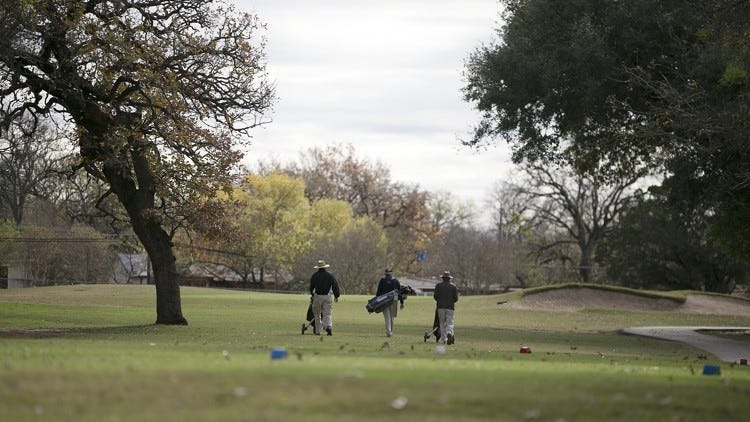AUSTIN, Texas — Volma Overton III asked the audience to imagine what the trees would say.
What would those Heritage trees overlooking Lions Municipal Golf Course — those iconic canopies strewn across those 141 acres in West Austin — tell us about its history?
“Imagine if all the trees out here could talk,” the 46-year-old lifelong Austin resident said of the 100-year space which opened in 1924. “Imagine the stories they would tell us.”
Overton, a third-generation golfer whose grandfather was one of the first Black residents to play on the city’s municipal course when it became South’s first to desegregate in 1950, honed in on that idea during the course’s centennial milestone celebration on Thursday, that Muny’s memories and traditions will be lost if redevelopment of the land and the course takes place.

A Texas Historical Marker at the entrance to Lions Municipal Golf Course in Austin, Texas. (Austin American-Statesman)
With fears raised following plans by the University of Texas to tear down the former University Junior High School, listed in the National Registry of Historic Places, to build a football facility, conservancy was front and center. “Muny,” as it’s called, also is on the National Registry.
Preservation of the course’s long-term impact for residents became a rallying cry during Thursday’s celebration, which included speeches from Mayor Kirk Watson, Congressman Lloyd Doggett and former LPGA and PGA professionals Cindy Figg-Currier and Mark Brooks.
Saving Austin’s oldest golf course
Watson was adamant that he would push to save the 100-year-old golf course, which is the second-largest green space in Austin outside of Zilker Park. UT owns a rolling lease on the land and has remained quiet about what the future might hold around it. While in the Texas Senate, Watson passed a bill — S.B. No. 2553 — enacted to help preserve the landmark.
But questions remain about its future.
“It’s a part of the effort I’ve been involved in and will continue to be involved in, to solve the longstanding uncertainty surrounding the future of this significant Austin treasure,” Watson said.
Watson finished his time at the podium by declaring a proclamation in honor of Lions Municipal Golf Course: “I, Kirk Watson, Mayor of the city of Austin, do hereby Proclaim October 3, 2024, as Lions ‘Muni’ Golf Course day in Austin.”
A celebration of Muny’s history
Watson and Doggett were ushered into their seats following an entrance of historic Ford Model-T cars, and their speeches were anchored by booming flyovers, cannon shots by UT’s Texas Cowboys and aerial banners announcing the course’s centennial celebration.
Just a little more than 30 golfers from Austin High also attended the ceremony.
A total of nine spoke in front of the gathered audience of roughly 500 residents, many of them members of the Lions Club and concerned citizens who vowed to keep one of Austin’s biggest green spaces alive. Roughly three months ago, just more than $1 million was raised at an annual “Save Muny” event.
Preserving fond memories of Muny
Figg-Currier was among them. Long ago, she had been a transplant from Michigan, an arriving college student who became a star at Texas and later joined the LPGA. Her memories – of practice rounds and changing grips and hole No. 16, which taught her how to hit a draw shot – were long and vast.
“I look at this place like an outdoor classroom,” she said. “It was a classroom for me and kids coming in and that’s what Texas does, is teach. And so that’s what we’re here to do, to teach. It’s multi-generational.”
Scotty Sayers, the president and co-chair of The Muny Conservancy, the nonprofit arm which aims to protect, preserve and restore the golf course and its history, said there was no way the city would be the same without the golf course, with 72,000 rounds and a total of 200,000 players coming through its gates yearly.
One among them? How about Luke Wilson, Sayers said.
“We’re putting here at 7 the other night,” Sayers said of Wilson. “We’re putting like in ‘The Legend of Bagger Vance.’ We were putting with the headlights on, having a fun little competition.
“You never know who you’re going to see out here,” he added.
Sayers called the piece golf course “priceless,” even as recent evaluations netted the value at more than $750 million.
And then there was Overton III, known to his closest friends as V3. His father, like his father before him, had taken him on the course when he was just a child. He was 7 when he first experienced the green space at Lions Municipal. Nearly 40 years later, his memories at the course remain, including many long nights chipping around the lion statue near the clubhouse.
The best shot of his life, he said, came at hole No. 3, a chip shot where he used a 9-iron.
“I think about it every time I walk by there,” he said.
Then again, he also remembers his worst shot, a devastating five-putt on No. 14.
“That’s a bad thing,” he said. “And I’ll never forget it either.”

